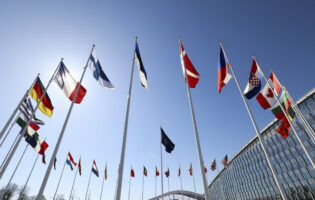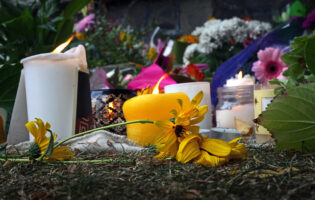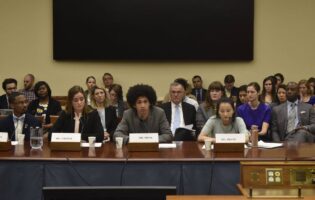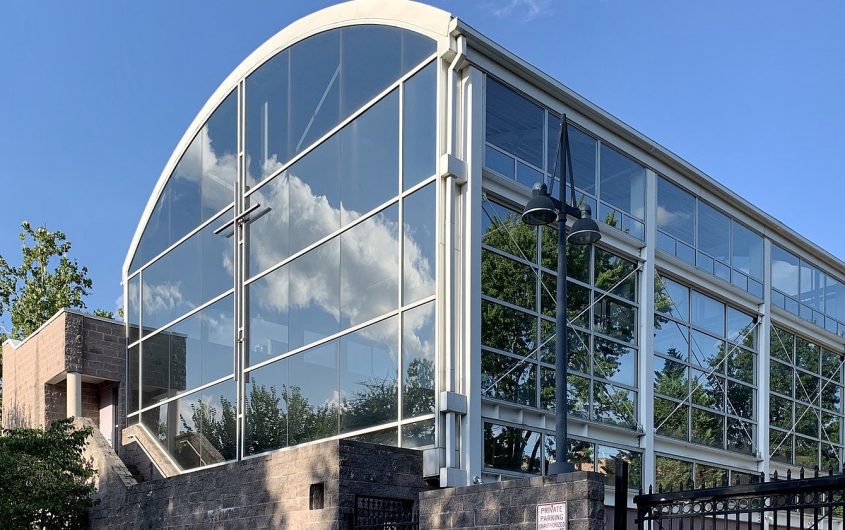
APK via Wikimedia Commons
Local Governance of Religious Diversity in Hamburg and Washington, DC
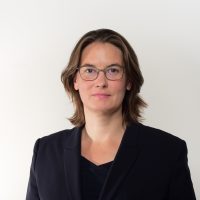
Anna Körs
University of Hamburg
Dr. Anna Körs is a DAAD/AICGS Research Fellow in October and November 2022.
She is scientific manager and vice director at the Academy of World Religions (AWR) at the University of Hamburg. She holds a Ph.D. in sociology and was Interim Professor for the sociology of religion at the Institute of Sociology at the University of Münster in 2018 and deputy head of the research project ‘Religion and Dialogue in Modern Societies,’ funded by the German Ministry for Education and Research, 2013-2018, at the University of Hamburg.
In her current research she focuses on the governance of religious diversity at the meso-level of organizations and institutions and investigates the processes of transformation in contemporary societies, focusing on religion, politics, and education, both qualitatively and quantitatively, and from a comparative perspective. She has published widely on the topic of governance and religion in several international journals including “Contract governance of religious diversity in a German city-state and its ambivalences” (Religion, State and Society, 2019), “Local ‘formulas of peace’: Religious diversity and state-interfaith governance in Germany” (Social Compass, 2018), “Interreligious Dialogue Activities in East Germany: Low levels of Activities within Official Organizational Structures” (Interdisciplinary Journal for Religion and Transformation in Contemporary Society, 2020), “The Plurality of Peter Berger’s ‘Two Pluralisms’ in Germany” (Society, 2017). She has also served as co-editor of the books Religious Diversity and Interreligious Dialogue (Cham: Springer 2020) and Religion and Dialogue in the City: Case Studies on Interreligious Encounter in Urban Community and Education (Waxmann, 2018).
During her time at AICGS, she will be expanding her previous research on German cities to the U.S. context and specifically conduct a comparative study of Hamburg and Washington, DC, by doing fieldwork and interviews. Based on theoretical considerations of urban sociology, religious studies, political science, and governance research on the relationship between cities and religions and assuming their recursive relationship the leading questions are: (1) Which forms of local governance have developed in the course of religious pluralization and secularization regarding the religious communities, the governmental level, and cooperative forms (in particular “state-interfaith governance”)? (2) What are the effects of the local governance of religious diversity, and does it help to accommodate religious diversity or foster mechanisms of exclusion? (3) How are the processes of local governance linked to the national level of religious diversity governance and influenced by the different models of church-state relations in Germany and the United States?
A Transatlantic Perspective
Germany is an increasingly heterogeneous society. This has become obvious by the Bundestag elections in September 2021. For the first time in the history of the Federal Republic, there was no longer one dominant party, but a whole series of smaller parties vying for coalition alliances until, likewise for the first time at the federal level, the Social Democrats (SPD), the Greens, and the liberal Free Democrats (FDP) formed a governing coalition. “Germany is entering a period of post-Merkel uncertainty” and faces the challenge to bridge differences and hold together a society that is not only politically fragmented.
From a sociological perspective, this is rather part of a broader process of differentiation in which society as a whole becomes more complex and solutions for living “together in difference” are becoming more urgent. This particularly affects the religious field in Germany, which has changed considerably over recent decades. Whereas in 1950, about 96 percent of the population still belonged to the Protestant or Catholic church, this figure is currently 54 percent and is expected to fall to 29 percent by 2060. By contrast, the number of members of other religious communities, as well as those without religious affiliation, is steadily increasing. Pluralization and secularization are the two defining developments that make the politics of coexistence the central challenge in multi-religious secular societies.
According to the global diagnosis by Peter L. Berger, these two parallel processes lead to two distinct problems for the political management of pluralism: “how the state defines its own relation to religion, and how the state sets out to regulate the relations of different religions with each other. In practical terms, this leads to a search for what I propose to call formulas of peace.”[1] By this, Berger primarily means national versions of church-state separation, that he believes are most likely to manage these “two pluralisms.” However, the challenge of the negotiation of the relationship both between the religions and between religion and secular society arises not only for Germany, as for many other countries, but especially also for cities in which both processes—pluralization and secularization—can typically be found in an even more intensified way. In a subnational perspective, we can therefore also speak of a plurality of two pluralisms.
It is therefore argued that in addition to the dominant national and global perspective, more nuanced analyses of smaller units such as states, municipalities, and cities are needed, focusing on local religious diversity and the question of “local formulas of peace.” Cities are the most important places where religious claims to participation and recognition are asserted and negotiated. Especially for migrants and their descendants, local structures and conditions represent relevant orientation for actions that are often associated with a sense of belonging which emphasizes the direct urban environment in contrast to any national identification. In Germany, the central importance of cities also arises against the background that the federal government, despite immigration since the 1950s, did not see Germany as a country of immigration until the 1990s. As a result, integration policy was for a long time not considered of national importance, but a task primarily of municipalities and cities. Cities, as meso-level sites between macro-level overarching developments and regulations and micro-level individual action, are central in their role of negotiating, mediating, and implementing local solutions for living together in multi-religious secular urban societies.
The subnational level, and cities in particular, play an important role as condensed spaces of religious diversity, serving as laboratories for shaping and evaluating forms of coexistence in pluralistic societies.
Despite their differences, Hamburg and Washington, DC, have structural similarities in several respects: both are religiously highly diverse cities, with about 600 local religious communities in Hamburg and, according to DC Open Data, more than 770 places of worship in Washington; they each have developed strong interfaith infrastructures including the Interfaith Forum Hamburg (IFH), founded in 2000, and the Interfaith Council of Metropolitan Washington (IFC), founded as early as 1978, as a network of leaders and representatives from different religious communities; most interestingly, both are also more recently creating state-interfaith collaborations, such as the “state contracts” with Muslim communities concluded in Hamburg in 2012 by Olaf Scholz, former mayor of Hamburg, and in Washington, DC, e.g., the Interfaith Preparedness & Advisory Group (IPAG) initiated by the government in 2019. Moreover, in a multilevel perspective, they are both, albeit in different ways, of national importance—Hamburg as the “second (largest) city” and one of the sixteen Länder (regional states) of Germany, Washington, DC, as the capital of the United States—and allow for analysis of the local governance of religious diversity as well as its embeddedness in national policies.
Based on several empirical studies in Hamburg and more than fifteen interviews with representatives from different faith communities, interfaith organizations, city government, as well as academics in Washington, the essay explores how “the city” deals with religious diversity: How do religious communities respond to religious diversity and what role does interfaith dialogue play? What role do religious spaces play in dealing with diversity? And how does the state respond to religious diversity and interact with religious communities?
Interfaith dialogue: conversation, politicization, and power
Hamburg understands itself as being the “capital of interreligious dialogue” and a pioneer in dealing with religious diversity. This is based on an early local development of an interreligious infrastructure including the “Hamburg model” of interfaith religious education (RE) in public schools (instead of the elsewhere-common confessionally divided RE classes) as a joint affair of state and religious communities and the only school subject guaranteed by the Basic Law. It also mirrors the national tendency in Germany towards a strong institutionalization of interfaith dialogue that has developed across spatial levels (local, regional, national, international) and with the expansion of actor relationships (interreligious, multireligious, state-interfaith) and has thus become a complex field of interaction. One particularly striking feature is the strong political engagement over the last decade so that interfaith dialogue has developed beyond a theological concern to a societal project, frequently being seen as a political strategy or even instrumentalization of religious communities for the governance of religious diversity. In Washington, according to the Pluralism Project at Harvard University, more than forty interfaith organizations exist. The interreligious infrastructure not only seems more extensive in terms of the number of organizations members and size, but it also differs in content: “I think in the United States they would refer to it as the dialogue of life not the dialogue of doctrine or the dialogue of belief. Yes, there is room for all of those conversations but there are some things out here that need to be taken care of whether it’s housing or whether it’s hunger. And, what’s preventing us from working together on these.”
Despite different understandings of interfaith dialogue, this “dialogue of life” is very much present when its main concern of addressing social issues is further advanced by the Washington Interfaith Council as one of the “faith-based community organizations,” which are widespread in the United States. With 45 mainly religious member institutions, the Council is faith-based but primarily addresses community issues and initiates campaigns on e.g., affordable housing, public safety, or climate change. “Our action is holding politicians accountable to a vision sort of what the world as it could be rather than how it is. And it has a priority for people who are not usually at any tables of power […] It is to gain power so that we can act,” according to one interview partner.
Obviously, on the one hand, the religious communities in both cities play a central role in dealing with religious diversity, and interfaith dialogue in particular is seen as a promising vehicle for peaceful coexistence in a religiously plural and secular society. On the other hand—and as a thesis—the understanding and practice differ when in Hamburg interfaith dialogue is rather politicized by the state and serves the cooperation with religious communities, while in Washington interfaith dialogue is rather politicized by religious communities to address social issues and to confront and put pressure on the government.
Religious spaces: expression, shaper, and vision of plural societies
The governance of religious diversity is not only a question of interreligious action and practice but has also a strong spatial dimension. In Hamburg and other German cities, this is reflected by at least three developments: First, due to secularization processes, Christian churches try to preserve their buildings as “symbolic capital” by restaging them as “city churches,” programmatically opening its doors to groups of visitors outside of the religious community life. Second, due to migration-related pluralization processes, non-Christian minority religions are making new places by either building mosques, synagogues, or temples or by transforming places such as a church-mosque conversion in Hamburg and thus become more visible in a still Christian-dominated environment. Third, multi-religious spaces are emerging or planned as a new phenomenon—such as the “House of One” in Berlin where a church, a synagogue, and a mosque are to be built under one roof—with the vision of making a significant contribution to interfaith and social dialogue.
In Washington, DC, too, though constructed and built as the capital city and shaped by political architecture, religious spaces matter for dealing with (religious) diversity. To give just two examples: The Washington National Cathedral removed two windows honoring Confederate generals in 2017 and has temporarily established a light installation titled “Windows of Racial Justice” until newly designed windows will be installed in 2023. The new windows will tell “a new and more complete” story of the nation’s racial history and “make people even more aware of our history and who we are,” as a person from the church put it in a conversation. While the National Cathedral serves as a symbol and addresses nationwide debates about racial justice, the Metropolitan Community Church of Washington DC was originally designed to promote diversity and has a more local impact. It is the first church built in the United States by an LGBT religious community. Designed by a local architect, it is a small but imposing building with its glass sanctuary offering panoramic views of the sky and surrounding area that has been praised for its metaphorical openness and transparency and has “impacted the community, the neighborhood, and even the architecture of other buildings in the area,” as a representative of the church said.
In both cities, religious spaces, with their visibility and materiality, appear particularly socially productive by creating perceptible places that make the plural society representable, criticizable, and recognizable and in turn create spaces for its social negotiation. This spatial dimension is often overlooked and underestimated in practice and in research, which usually looks at religious spaces from a conflict perspective, while the potential of religious spaces is still underexposed.
State-religion relations: between cooperation and separation
Given the German cooperative model of state-religion relations and the responsibility of the Länder for religious affairs, Hamburg has taken a special path insofar as it is the only state (besides Bremen) that has concluded “state contracts” with Muslim and Alevi communities recognizing and insuring their rights in terms of religious education, buildings, funerals, holidays, etc. The contracts first became part of the political agenda in Hamburg in 2001 in the wake of the 9/11 attacks in New York and Washington, DC. However, due to the participation of a right-wing populist party in the Hamburg government at the time, these were pursued only in 2006 when the then head of the Christian Democratic Party (CDU) one-party government, Ole von Beust, made “state contracts” a central component of integration policy despite the resistance of his party. After another change of government and six years of negotiations, they were signed by Mayor Olaf Scholz in 2012 and ratified with the votes of the SPD, the Greens, and the Left, as well as the majority of the CDU faction in Hamburg’s parliament, and were considered a model for other regional states and even countries. Since the last paragraph of the contract states that they are to be evaluated after ten years in 2022, they are currently under scrutiny, and with them this form of “contract governance” of religious diversity in general.
In Hamburg interfaith dialogue is rather politicized by the state and serves the cooperation with religious communities, while in Washington interfaith dialogue is rather politicized by religious communities to address social issues and to confront and put pressure on the government.
Interestingly, and contrary to what one might expect given the stricter separation of state and religion in the United States, several structures and co-operations between the government and religious communities exist in Washington, including the Mayor’s Office of Religious Affairs addressing citywide issues, which is also connected to the Interfaith Council as an advisory board composed of the various religious communities; the Interfaith Preparedness & Advisory Group, initiated by the government in 2019 as a new platform for faith-based organizations to exchange information with security on threats, vulnerabilities, and protective measures related to the safety and security of congregations and facilities; and the Places of Worship Advisory Board, which was initiated in 2008 by the former mayor and established at the DC Health Department. These intersections are just a few examples mentioned in the interviews, in which the relationship between the state and religion was also generally addressed and problematized in terms of its alleged clarity both locally and nationally:
“I do think that there is something pretty wonderful about DC […] that really intertwines religion with […] I mean we say that religion and government are separate, but they are just not. We see them both as providing meaning and structure to people’s lives. And I think I see that more here.”
“The U.S. reality has always been a world of separation between church and state. Let me try to figure out what that means […] I think they finally come to rest to say, ‘well we could cooperate as long as we are not giving them any money’ […] Now they began to identify certain segments of civil society, the religious groups, that might have a different role to play and they’ve been slowly identifying.”
In both cities, the local governance of religious diversity is nationally embedded but does not follow a top-down approach. Rather, it develops its own forms of cooperation and negotiation between religions and state actors. Further investigation could also be fruitful for considering cities as laboratories for creating and evaluating forms of coexistence in pluralist societies.
Conclusion
Religious diversity is a reality in both Germany and the United States, albeit in different forms. It leads to processes of negotiation in various forms that unfold between religions, state actors, and society. Given the dominance of national perspectives, especially with regard to the relationship between church and state, it is argued that the subnational level, and cities in particular, play an important role as condensed spaces of religious diversity, serving as laboratories for shaping and evaluating forms of coexistence in pluralistic societies. In doing so, a transatlantic cross-city perspective is analytically productive, showing how the governance of religious diversity in Hamburg and Washington, DC, takes shape locally while being embedded nationally.
[1] Peter L. Berger, The Many Altars of Modernity. Toward a Paradigm for Religion in a Pluralist Age (Boston, Berlin, De Gruyter: 2014), p. 79.



